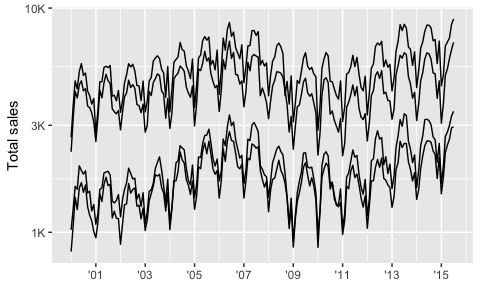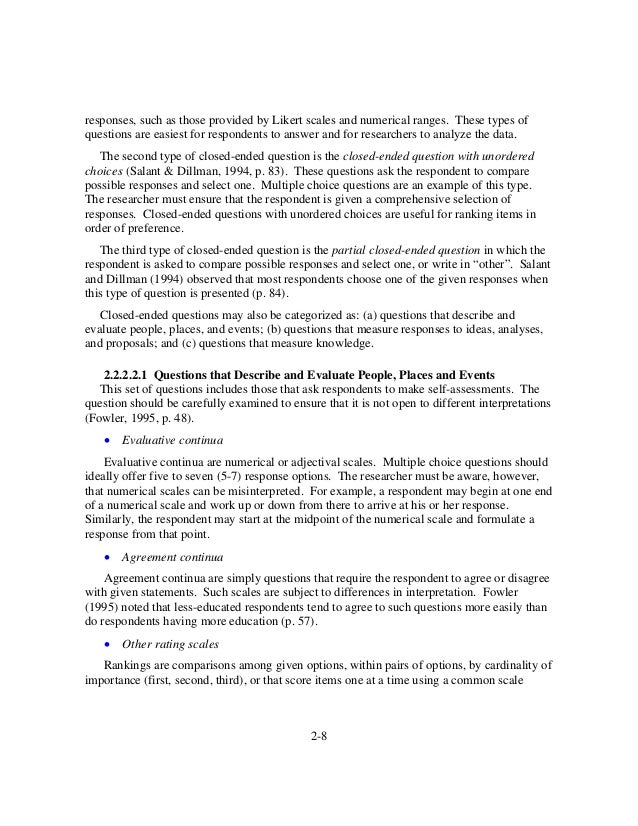41 response scales how many points and what labels
PDF Typical Survey Response Scales - STLHE True at all to Completely True) have a maximum reliability and validity at 5 points (Krosnick & Fabrigar, 2003) n Numeric labels seem to increase confusion rather than verbal labels (Krosnick & Fabrigar, 2003) n Agree/Disagree scales are less desirable than True/False scales for these reasons (Fowler, 1995): What is a Likert Scale? Definition, Examples, and Usage - SurveyLegend Difference Between 5 Point Likert Scale and a 7 Point Scale. Most researchers agree that the best Likert scales are the 5-point and 7-point varieties. This simply refers to how many responses the person has to choose from. Most Likert scales you see are going to be odd-numbered.
PDF Choosing Response Scale Labels and Length: Guidance for ... - DRO Correspondence Analysis of 5-point scale to 11-point scale 2.5 2.0 1.5 3eePoor Poor 1.0 1 e 0.5 0.0 -0.5 -4 -1.0 -3 4 e Fair -2 -1 Excellent Excellent e Very Good Good .7 6. o 5-point scale • 11-point scale Figure 2 shows that the relationship between the responses on the two scales is a U-Shaped curve.

Response scales how many points and what labels
(PDF) What Is the Best Response Scale for Survey and Questionnaire ... Results will make researchers able to make decision on what number of Likert scale points use for their survey and questionnaire. Taken as a whole this study suggests using of seven-point rating ... A Search for the optimum feedback scale The 3-point scale was employed on a questionnaire measuring 5 competences with 7 questions for each competence. Results showed a high degree of positive skew, 65% of responses were 'adequate,' 25% were 'strength' whilst only 10% of responses were 'development needed.' 15 Common Rating Scales Explained - MeasuringU The classic Likert item uses a 5-point response scale, but you can use 7, 9, or other points, too. (Although someone will have a strong opinion about the "right" number of steps. ) Because the response scale is about agreement, be sure items are phrases participants can agree or disagree to.
Response scales how many points and what labels. Survey Response Scales - Answer Format and Types of Questions Responses can be as simple as a choice between "Yes" or "No" or as complex as choosing an answer among seven response options. The response options for each question in your survey may include a dichotomous, a three-point, a five-point, a seven-point or a semantic differential scale. Each of these response scales has its own advantages and disadvantages, but the rule of thumb is that the best response scale to use is the one which can be easily understood by respondents and ... Color, Labels, and Interpretive Heuristics for Response Scales Providing verbal labels for each scale point seems to help respondents (Krosnick and Fabrigar, 1997), but respondents also draw on other cues in interpreting response scales, including numerical labels attached to the scale points and such visual cues as the shape of the scale (Schwarz, Grayson, and Knäuper, 1998) or the spacing of the ... 20 Free Ready-Made Survey Rating Scale Examples - AidaForm Multiple Rating Matrix. This type of rating scale is very widely used in online surveys. It looks like a compact version of four Linear Numeric Scales put together. Please rate your attitude towards each of the brands. 1 - not at all favorable, 7 - extremely favorable, N/A - I do not know the brand. 1. (PDF) Choosing response scale labels and length: Guidance for ... Whereas for 10-point scale there are criticisms about the difficulty to clearly state the word labels in the scale, and it would be more time consuming for respondents to process the answers ...
Response Options - Designing Surveys for Evaluations and Research For Likert-type response scales, the labels used to identify each option on the scale need to be ordinal in nature and mutually exclusive (clearly different). A middle point should only be used when there is a true middle position participants might take. When using a Likert-type response scale, the statement used in the item stem must be a clear statement that is not ambiguous, ambivalent, or a generally accepted declaration. Carefully pilot test all items you create. Response Scales' Length - SOCIOMETRIC RESEARCH FOUNDATION The optimal number of points in a scale should be taken into consideration in relation to the polarity of the scale (Alwin 2007).* ... The effect of rating scale format on response styles: the number of response categories and response category labels. Int. J. Res. Mark. 27, 236-247. DOI: 10.1016/j.ijresmar.2010.02.004 << type of response scales. PDF Response scales - UIC CONSTRUCTING RESPONSE SCALES: How many scale points should I include? Unipolar v. bipolar How should I label scale points? Verbal v. numbers v. pictures Endpoints v. endpoints and midpoint v. fully labeled Should I include a midpoint? NUMBER OF SCALE POINTS: Survey questions use a wide range of number of scale points, varying from: Two response options: Survey Response Scales: How to Choose the Right One - CXL 3 types of survey response scales. When designing surveys, there tend to be three different models for survey response scales: Dichotomous; Rating scales; Semantic differential scales. 1. Dichotomous scales. Dichotomous scales have two choices that are diametrically opposed to each other. Some examples: "Yes" or "No"; "True" or "False";
Should I label all scale points or just the end points for attitudinal ... By Aaron Maitland. Should I label all scale points or just the end points for attitudinal questions? Writing Good Surveys: Response Scales | Questionmark Writing Good Surveys, Part 5: Finishing Up on Response Scales. If you have not already seen part 4 of this series, I'd recommend reading what it has to say about number of responses and direction of response scales as an introduction to today's discussion. To label or not to label, that is the question (apologies to Mr. Shakespeare). Writing Good Surveys, Part 4: Response Scales - Questionmark These are the scales that elicit the most amount of debate among the experts, and I strongly encourage you to Google "survey response scales" and do a little reading. The main points of discussion are number of responses, direction, and labeling. Number of Responses. We've all seen the minimalist approach to rating scales: A classification of response scale characteristics that ... - SpringerLink Fixed reference points are verbal labels used in a scale to prevent variations in the response functions and set no doubt about the position of the reference point on the subjective mind of the respondent (Saris 1988; Saris and Gallhofer 2014). For instance, the use of "always" and "never" can be fixed reference points on objective scales, and the words "not at all", "completely", "absolutely" and "extremely" for subjective scales.
Type of response scales - SOCIOMETRIC RESEARCH FOUNDATION An absolute metric scale is where respondents should select a point on a continuum. Dichotomous scales only provides two substantive response options. Typical dichotomous scales are yes-no and true-false scales. Rating scales provide three or more categorical options. Closed quantifiers are mainly used for objective variables such as the ...
What Is the Best Response Scale for Survey and Questionnaire Design ... points use for their survey and questionnaire. Taken as a whole this study suggests using of seven-point rating scale and if there is a need to have respondent to be directed on one side, then six-point scale might be the most suitable. Key Words Response Scale, Rating Scale, Attitude Scale, Liker Scale, Scaling Method, Response Rate,
How to Label Response Scale Points in Your Survey | Qualtrics Here's an example of a seven-point bipolar scale where, through the use of appropriate modifiers, all responses are mutually exclusive of one another. Finally, to ensure that you get the highest-quality data possible, keep these four guidelines in mind as you practice labeling response scales:
Should All Scale Points Be Labeled? - MeasuringU What's more, there's also the practical problem of coming up with the right labels for scales with more than five or seven points. For example, coming up with labels for each of the points on the eleven-point Likelihood to Recommend item would likely be impractical; endpoints and a neutral label may be all that can be done. But labeling each response option for five- and seven-point scales is practical and a fairly common practice.
Survey Rating Scales to Guide Survey Respondents Effectively Five point scales are most popular followed by seven point scales. These scale ranges tend to work best. Beyond a 7 point scale participants have trouble responding the same way if they repeated the survey, so we recommend staying away from anything above 7 points. Here is an example of a 5 point Likert Rating Scale: Strongly disagree; Disagee; Neutral; Agree; Strongly Agree
What is the Most Effective Response Scale? - LearningBridge Surveys use anywhere from 3 to 11 points in the response scale for the items. Here are some things to keep in mind: An odd number of points—like 3, 5, or 7 points—allows the respondent to indicate a "neutral" middle answer.
Survey Scales: Which Response Scale Works Best for You? - OptiMonk This response scale allows the survey participants how much they agree or disagree on a statement. Typically, Likert Scales use a 3-point or 5-point system, meaning there are three to five choices to pick from. You will notice questions that usually have the following options: Very satisfied, satisfied, neutral, dissatisfied, very dissatisfied.
Your Guide to Rating Scale Questions in 2022 - Qualtrics If you're dealing with an idea or construct that ranges from positive to negative - think satisfaction levels - (these are known as bi-polar constructs) then you're going to want a 1-7 point scale that includes a middle or neutral point. In practice, this means the response options for a satisfaction question your Likert scale labels should look like this:

Can I use parametric analyses for my Likert scales? A brief reading guide to the evidence-based ...
How to Label Response Scale Points in Your Survey to Avoid Misdirecting ... Have you ever been following navigation instructions while driving and wished that an instruction or street sign would've been more clear or specific? Maybe you couldn't tell...
How to Choose the Right Employee Survey Response Scales Likert scales are usually five-point, seven-point, or ten-point, bipolar scales that capture responses from one extreme to the other. Likert scales help quantify otherwise unquantifiable factors such as emotions and attitudes. For example:
15 Common Rating Scales Explained - MeasuringU The classic Likert item uses a 5-point response scale, but you can use 7, 9, or other points, too. (Although someone will have a strong opinion about the "right" number of steps. ) Because the response scale is about agreement, be sure items are phrases participants can agree or disagree to.
A Search for the optimum feedback scale The 3-point scale was employed on a questionnaire measuring 5 competences with 7 questions for each competence. Results showed a high degree of positive skew, 65% of responses were 'adequate,' 25% were 'strength' whilst only 10% of responses were 'development needed.'
(PDF) What Is the Best Response Scale for Survey and Questionnaire ... Results will make researchers able to make decision on what number of Likert scale points use for their survey and questionnaire. Taken as a whole this study suggests using of seven-point rating ...












Post a Comment for "41 response scales how many points and what labels"